Greetings all - post #1.
I’ve been posting some questions re. my P8Z77-V with Corsair Force 3 SSD RAID 0 on the Corsair forums, would be interested in thoughts from people here (and hopefully my experience might be helpful).
Built the machine in late 2012 and it’s run flawlessly since.
Before commencing the Win7 Pro 64 install, I flashed the SSD’s (2 x Force 3 90GB) to the then current firmware, the P8Z77 BIOS to 1805 (SATA OROM 11.0.0.1339), and then installed Intel Rapid Storage Drivers (IRST) v.11.1.0.1006
No changes to the system since, apart from 2 changes of GFX cards, and the machine has worked absolutely flawlessly in the past 2+ years, day-in day-out…
However, I benchmarked the SSD RAID for the first time a few days a ago, and found a large drop-out in read-speeds at small-size blocks was revealed , so I updated IRST to v.12.8.0.1016 and saw a huge increase in them (2-3x), but also a drop in write-speeds at these block sizes (3 steps forward and 2 back, as they say).
Nonetheless I Immediately noticed the improvement in responsiveness - MUCH faster program loading, and slightly faster boot.
Here are the ATTO benches compared;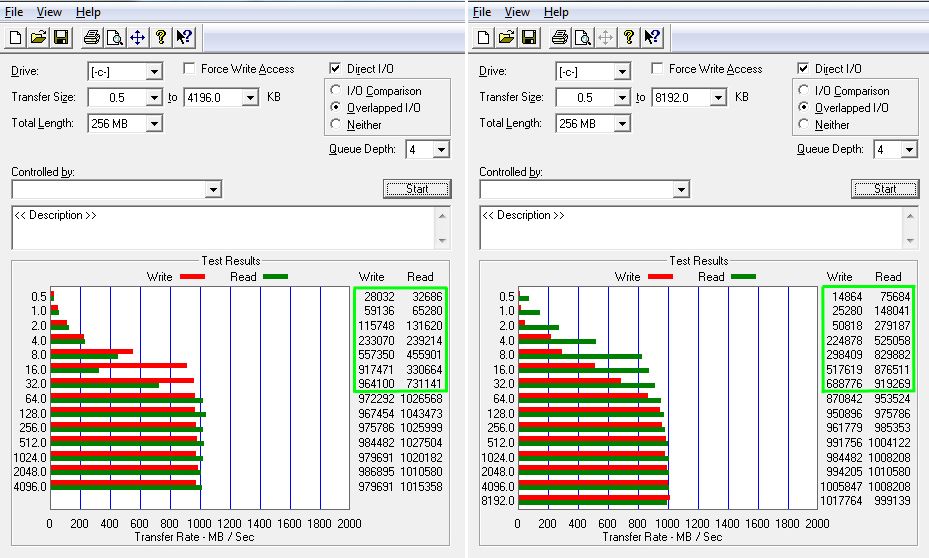
All of which brings me to the simple question;
would a later SATA OROM (i.e. flashing with an UBU modified BIOS) be likely to improve performance still further?
@ MRAScott:
Welcome at WinRAID Forum and thanks for your interesting report.
According to my own experiences the Intel RAID ROM version has not a big impact on the performance, but maybe on the stability of a RAID system.
I am wondering about your detected performance boost after having updated the Intel RAID driver to a v12 series one, because I have done some benchmark comparison tests today using the same mainboard as you, but with an extremely different result (look >here<).
By the way:
The ATTO benchmark test results do not show the real performance of the system during the user’s daily work (look >here<). This is an excerpt from the article:
Question:
Do you have a done some benchmark tests by using AS_SSD or Anvil’s Utilities?
Regards
Fernando
!!! Many thanks for the quick reply, Fernando!.
According to my own experiences the Intel RAID ROM version has not a big impact on the performance, but maybe on the stability of a RAID system.
I am wondering about your detected performance boost after having updated the Intel RAID driver to a v12 series one, because I have done some benchmark comparison tests today using the same mainboard as you, but with an extremely different result (look >here<.
Well, the results were pretty consistent with the v11.xxxx driver - always the dip in read speeds at 4 - 32 KB but (oddly) quite fast writes (the ‘drop-out’ in read-speed improved somewhat if I shut down all running software).
This is (also consistently) reversed with the v12.xxxx driver - fast reads, slower writes. The faster loading of programs is VERY noticeable, though.
I’ve only used ATTO and Crystaldiskmark so far - not very impressive results with the latter with either driver (neither read nor write exceeding the speed of a single Force 3 at any block size). I’ll try the other programs ASAP and post the results.
cheers,
Mark.
ETA >> just begun reading thru the results you obtained with various combinations of OROM and drivers - interesting stuff. Also the SSD benchmarks - my Force 3 RAID is giving roughly the speed of a single drive.
The problem I have is that although it’s pretty clear that the RAID isn’t running optimally, it has always been incredibly stable and I don’t want to break it!
ETA 2 >> P8Z77 V (BIOS 1805) * i5 2500K @4.2GHz * 2x Corsair Force 3 90GB SSD RAID 0 * 2x WD Caviar Green 500GB RAID 0 (Intellipark @ 300 sec) * 2x 4GB Corsair Vengeance DDR3 @1600 * Gigabyte nVidia GTX 660 Graphics * Asus Xonar Essence STX audio.
These are the first runs with Anvil and AS SSD (very different numbers to ATTO, as expected, but quite similar to CrystalDiskMark benches as I recall - unfortunately I never recorded/screen-capped any of those though);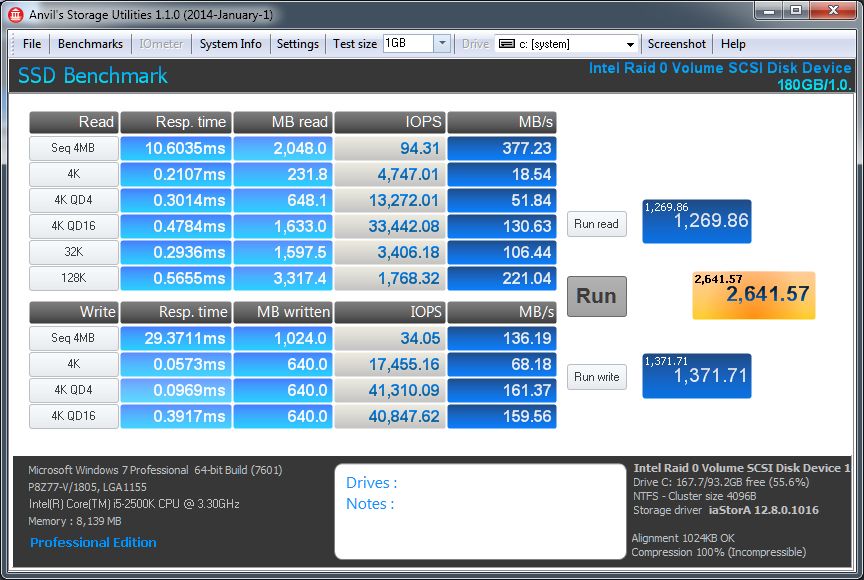
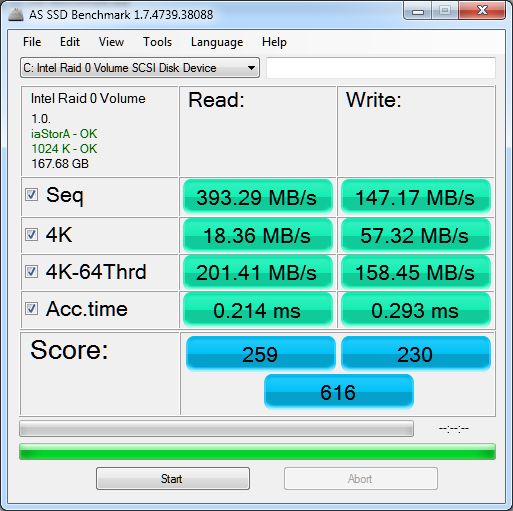
I haven’t compared them with others yet (I almost daren’t look).
One of the main problems of the Sandforce Controller SSDs like the Corsair Force 3 is the limited TRIM support.
Hi F.,
trim has always worked well. It was one of the things I made sure of when I was building the machine (hence the v. 11.xxxx OROM and drivers).
I didn’t know what trim was when I ordered the parts, but quickly educated myself, and luckily found that it’s supported in RAID on the Z77.
All by chance, BTW.
I didn’t intend to use a RAID system drive - I bought a 90GB Force 3 and then realised it wasn’t big enough, so bought another one and took a chance that they’d work reliably in RAID, which they have, thankfully (spectacularly well). (ETA >> and knock on wood!).
ETA 2 >> some of you might remember how cheap SSD’s and RAM were in late 2012 and just into 2013 - we won’t see that again, I’ll wager.
ciao.
Ok - checking against a lot of other benchmarks, this is what I’m getting;
compared with a single Force 3, read speeds for incompressible data at all block-sizes (Crystaldiskmark, AS SSD and Anvil) are better across the board , starting at about 20% at 4KB and almost double from 32KB up (and for large sequential reads).
Writes are another matter. With the v12.xxxx IRST driver they’ve dropped off with small blocks/incompressible data to the point that my RAID is slower than a single drive until about 32KB, only then finally matching and then eventually reaching c. twice the speed.
With small-block compressible data (ATTO) they’ve taken less of a hit, but still behind what I’d expect ( and much slower than reads, which I haven’t seen in any other benches, whether single drives or RAID), and well down on what was previously achieved with the v11.xxxx IRST driver.
Like I said - 3 steps forward and 2 back!
At some point I might try the later Intel SATA RAID OROM (I already have the modded BIOS files ready to go) - I’ll be a happy bunny if I can get the best of both worlds.
BTW, a single Force GT or similar synchronous NAND SSD would be much faster everywhere except large sequential transfers (which is of almost zero relevance for a OS/system drive. The only time it might be of use is if ‘scratch disk’/ temp files for applications such as audio editors were located on it))
just back from the usual heart-in-mouth BIOS flash.
Stayed with 1805 (2 versions old, but I vaguely recall having problems with the next newest way back in early 2013) UBU’d with the v12.xxxx RAID OROM. IRS driver is now 12.9.4.1000.
No radical changes in benches, still rather low small-block write speeds.
Only thing left to try is OS re-install, which I guess is looming after well over 2 years anyway.
Latest benches with Anvil and AS SSD.
I went back to the 12.8.13.1000 RST drivers for these.
RAID OROM 12.XX (as edited into P8Z77 BIOS rev. 1805 by UBU)
I think they’re the best I’ve seen, or will ever see overall, barring a fresh Win7 install.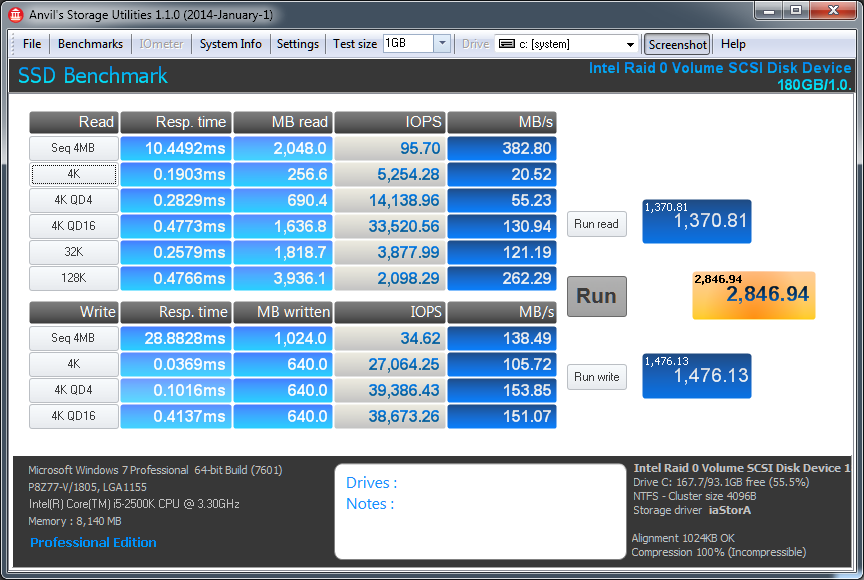
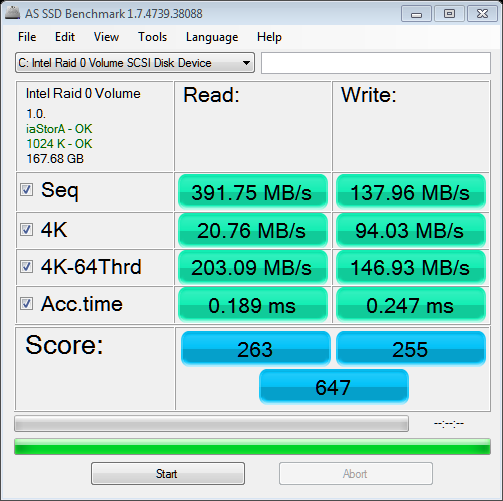
@ MRAScott:
Thanks for the benches.
I am not sure about that. Have you ever tried the Intel RAID driver/ROM combo v11.2.0.1006/v11.2.0.1527?
I am not sure about that. Have you ever tried the Intel RAID driver/ROM combo v11.2.0.1006/v11.2.0.1527?
Hi F.,
It’s difficult keeping track - I confess I’m being less than methodical.
All the ‘official’ Asus BIOS revisions, as far as I know, have the same RAID OROM (11.xxxx), and that was what I was using with 11.xxxx IRS drivers until two days ago.
To recap;
I benched and found that with there was a drop-out in read-speeds at small block sizes, but great write speeds.
Updated drivers to 12.xxxx and saw the small-block reads improve, but the small-block writes took a big hit (but overall, more balanced).
The BIOS flash has improved the small-block writes somewhat.
I’m not inclined to flash BIOS again, or install yet more IRS drivers at this point.
There was an overall improvement in program loading with the faster small-block reads with the 12.xxxx IRS drivers and 11.xxxx OROM, and another slight improvement with the 1805 BIOS and 12.xxxx OROM.
AS ever, after over 2 years of installing and tweaking I’m loathe to do a complete OS re-install, but I guess it’s inevitable, sooner or later
Just to clarify;
I always had the 11.2.0.1006 drivers (from the original build 2+ years ago), with whichever OROM was included in Asus BIOS rev. 1805.
ETA >> and which gave these (weird) ATTO benches;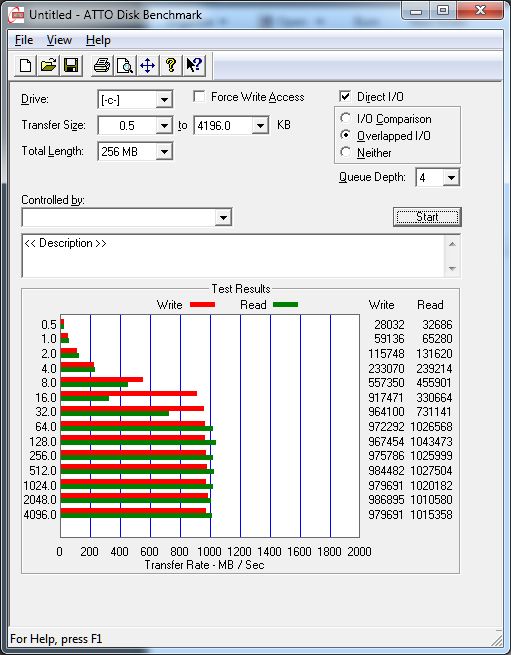
With ATTO you can not see the real performance of the system.
I realise that now (it uses raw, compressible data?), but nonetheless the drop-out in read-speeds (while writes were unaffected) was quite pronounced, and disappeared with the 12.xxxx driver, which produce a much more uniform curve (abut slower reads!).
Overall, the results in other benches are more consistent as well, and I gather that small-block reads have the most impact on responsiveness/program loading times.
Just a reminder - the change from IRS v11.xx to v12.xx seemed to completely reverse the asymmetry in compressible small-block read vs. write speeds;
-Would be great if I could get the write-speeds on the left (IRS 11.xx) combined with the read-speeds on the right (IRS v12.xx).
(probably get another slap on the wrist from Fernando for paying heed to ATTO benches again!)